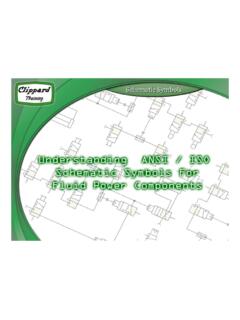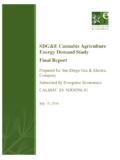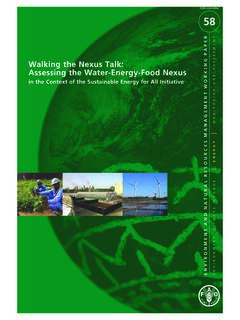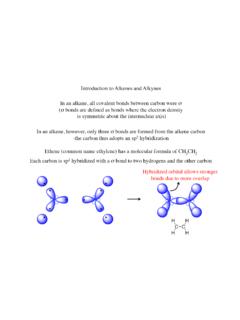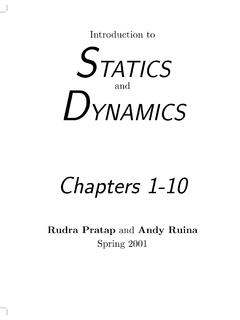Transcription of Introduction to Pneumatics and Pneumatic Circuit Problems ...
1 Introduction to Pneumatics and Pneumatic Circuit Problems for FPEF Trainer Fluid Power Education Foundation 3333 N. Mayfair Road Suite 101 Milwaukee, WI 53222 Phone: (414) 778-3364 FAX: (414)778-3361 John R. Groot President FPEF John Nagohosian FPEF Educational Coordinator John Prisciandaro Birmingham Covington School Birmingham, Michigan Dan Butchko Derby Middle School Birmingham, Michigan Reference Page Fluid Power Educational Foundation National Fluid Power Association International Fluid Power Society Fluid Power Distributors Association Parker Hannifin Corporation Clippard Minimatic Introduction to Pneumatics with Circuit Design Problems for the FPEF Trainer Prepared by.
2 John Prisciandaro and Dan Butchko, Birmingham Public Schools, Birmingham, Michigan Sponsored by: Fluid Power Educational Foundation, 3333 North Mayfair Rd., Milwaukee, WI 53222-3219 This FPEF curriculum is designed to be used in conjunction with a Pneumatic trainer capable of demonstrating the principles and circuits outlined in the curriculum. The FPEF website provides links to the manufacturers that have produced and made available a trainer capable of being used with the curriculum. This combination provides a comprehensive and hands-on Introduction to Pneumatics and Fluid Power capabilities.
3 : The Fluid Power Educational Foundation, with its members, have designed this training panel and manual to help technical teachers and industrial trainers facilitate a hands-on experience with Pneumatics . The FPEF is grateful to its members for their hard work and financial support that has made this effort possible. Special thanks to John Nagohosian-Educational Coordinator, John Groot-President, and Paul Gant-Treasurer, who initiated and guided the project along with their legwork, expertise and resources. John Prisciandaro and Dan Butchko, who prepared this manual, are Engineering Technology teachers in the Birmingham Public School District, Birmingham, Michigan.
4 Both John and Dan have been involved in previous FPEF sponsored activities, including teacher training sessions, and developing and presenting unique methods of integreting fluid power applications in science and technology courses. Clippard Instrument Laboratory, Inc. and Parker Hannifin Corp., who allowed the use of their technical reference manuals and application Problems , which provided much of the information in this manual; Mike Pierno, Engineering Technology department head at Seaholm High School, Birmingham Public School District, whose program has been in existence for many years, and has actively participated in numerous FPEF sessions.
5 Mike has been responsible for turning on hundreds of students to the fluid power/motion control industry and was recently awarded the honor of Key School by the FPEF. About the FPEF The FPEF promotes technical education that integrates fluid power. The Foundation is always striving to raise the level of competence of young people entering our industry and improve visibility for fluid power technology. For information regarding teacher training sessions, and other activities of the FPEF, contact: The Fluid Power Educational Foundation 3333 N. Mayfair Road Milwaukee, WI 53222-3219 Telephone #414-778-3364 Fax #414-778-3361 Fluid Power Educational Foundation Introduction to Pneumatics 1 Pneumatic Transmission of Energy The reason for using Pneumatics , or any other type of energy transmission on a machine, is to perform work.
6 The accomplishment of work requires the application of kinetic energy to a resisting object resulting in the object moving through a distance. In a Pneumatic system, energy is stored in a potential state under the form of compressed air. Working energy (kinetic energy and pressure) results in a Pneumatic system when the compressed air is allowed to expand. For example, a tank is charged to 100 PSIA with compressed air. When the valve at the tank outlet is opened, the air inside the tank expands until the pressure inside the tank equals the atmospheric pressure. Air expansion takes the form of airflow.
7 To perform any applicable amount of work then, a device is needed which can supply an air tank with a sufficient amount of air at a desired pressure. This device is positive displacement compressor. What a Positive Displacement Compressor Consists of A positive displacement compressor basically consists of a movable member inside a housing. The compressor has a piston for a movable member. The piston is connected to a crankshaft, which is in turn connected to a prime mover (electric motor, internal combustion engine). At inlet and outlet ports, valves allow air to enter and exit the chamber.
8 How a Positive Displacement Compressor Works As the crankshaft pulls the piston down, an increasing volume is formed within the housing. This action causes the trapped air in the piston bore to expand, reducing its pressure. When pressure differential becomes high enough, the inlet valve opens, allowing atmospheric air to flow in. With the piston at the bottom of its stroke, inlet valve closes. The piston starts its upward movement to reduce the air volume which consequently increases its pressure and temperature. When pressure differential between the compressor chamber and discharge line is high enough, the discharge valve opens, allowing air to pass into an air receiver tank for storage.
9 Fluid Power Educational Foundation Introduction to Pneumatics 2 Control of Pneumatic Energy Working energy transmitted pneumatically must be directed and under complete control at all times. If not under control, useful work will not be done and machinery or machine operators might be harmed. One of the advantages of transmitting energy pneumatically is that energy can be controlled relatively easily by using valves. Control of Pressure Pressure in a Pneumatic system must be controlled at two points - after the compressor and after the air receiver tank. Control of pressure is required after the compressor as a safety for the system.
10 Control of pressure after an air receiver tank is necessary so that an actuator receives a steady pressure source without wasting energy. Control of Pressure after A Compressor In a Pneumatic system, energy delivered by a compressor is not generally used immediately, but is stored as potential energy in air receiver tank in the form of compressed air. In most instances, a compressor is designed into a system so that it operates intermittently. A compressor usually delivers compressed air to a receiver tank until high pressure is reached, then it is shut down. When air pressure in the tank decreases, the compressor cuts in and recharges the tank.






